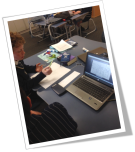This is a story of what happens when a Maths teacher looks around for real-world inspiration and then is prepared to “give it a go” when it comes to integrating new technologies into the classroom. The results and learning outcomes are, quite simply, staggering.
Ms Briony Marks, a Year 7 Maths and Languages teacher at St Andrew’s College, had a plan to enliven a Maths unit on Ratios and Proportions, by creating an extension task that required the students to design a house. Using a planning template from the Buck Institute for Educaction the class discussed the assessment criteria and outcomes and included a wider discussion on how the Key Competencies from the New Zealand Curriculum were going to be included into this unit. Here is the completed template used by the class to plan:
 This was a timely project because a number of the students in the class were having new houses built for their families during this unit so they could immediately connect with the learning. By designing a floor plan, the students had to decide on the ratios and proportions of three key areas in their house:
This was a timely project because a number of the students in the class were having new houses built for their families during this unit so they could immediately connect with the learning. By designing a floor plan, the students had to decide on the ratios and proportions of three key areas in their house:
- Living Areas
- Sleeping and Bathing Areas
- Storage and Access
To spice up the project and totally hook the students into it, they given the option to use Sketchup, Build With Chrome or Minecraft to design their house in. Ms Marks also created a simple task list of the required jobs that needed to be done to assist with scaffolding this project for the students.
With the task defined, students got to work by initially looking at concept plans by local builders such as Mike Greer Homes, and shading in the different areas they were going to have to design into their own houses. The maths, at this point, was tightly integrated into the inquiry – there was a need by the students to use conversion to change floor plans between millimetres, centimetres and metres. There was also teaching on calculating the perimeter of a house plan and of course the area of the various houses.
Ms Marks classified these as “unexpected extras” in the area of maths that supported the main focus of the unit on ratios and proportions, and there was also other skills being learnt by the students at the same time. One of these was formal communications, with a number of students contacting architects and house builders via email to obtain more information. Class and group discussion covered appropriate email etiquette, and emails were duly sent off, for example:
Student enthusiasm and engagement in this unit was incredibly high throughout, to the point that a number of students essentially self-taught themselves how to use Sketchup so that they could design a more professional looking home. Two of these boys, went on to present at the Burnside Learning Community Cluster professional development session as I blogged about earlier here.
Summary:
Some remarkable learning took place during this Maths unit that took just under three weeks to teach. It was notable that none of the students in the class had ever used any design software before and to that end, neither had Ms Marks:
I was just prepared to give it a go and learn alongside the students. I had a play with Sketchup in the library one afternoon and two of the boys saw me. By the following Monday they were sufficiently skilled in it to be able to teach others in the class the basics.
Attitude is key here: approaching a new technology with a positive and willing attitude to learn is invariably more successful than being afraid of not being an expert at it.
What really impressed me about this was the natural integration of technology into the learning area, and how deeply embedded the core maths skills were into everything the students had to do to achieve the chosen outcomes. The fact that students had input into the planning at the outset undoubtedly helped with their sense of engagement in the learning process too.
Following the conclusion of this unit, Ms Marks was asked to present a summary of it to at a Preparatory School staff meeting. This is a link to her powerpoint and it covers off her planning and running of the unit.
FOLLOW UP:
Other students in the Preparatory School were invited to come and view the final designs and vote for their favourite. Over 120 votes were cast amongst the students and staff, resulting in the awarding of certificates for the following three categories:
- Architect’s Choice
- Teacher’s Choice
- People’s Choice
Well done to Ms Marks and all her Year 7 students who gave it a go.









Pingback: Starting Back | Miss Marks Blogs
Pingback: Pedagogical Speed Dating – Our Cluster Conference | Miss Marks Blogs